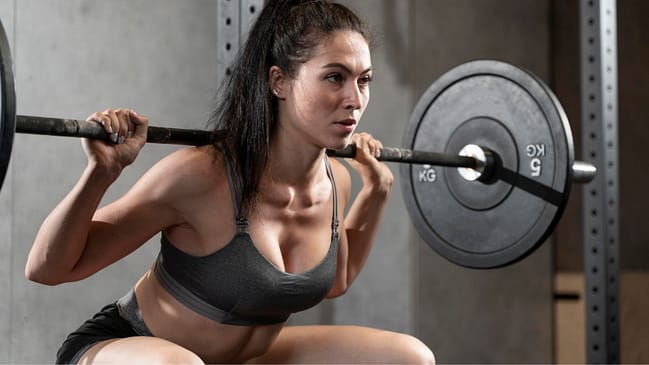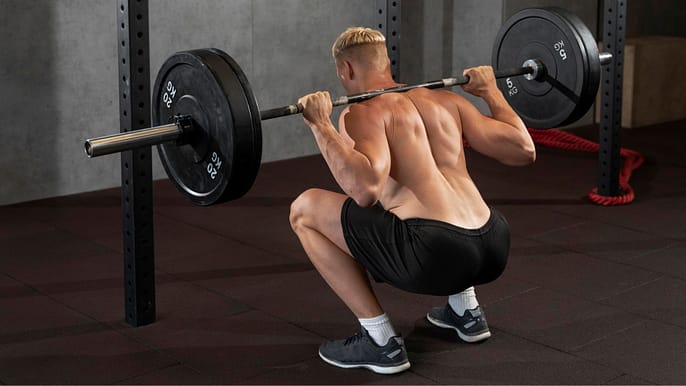Table of Contents
ToggleThe Science Behind Daily 100kg Back Squats: Impact on Body Fat and Glutes

Understanding the 100kg Back Squats:
The back squat is a compound exercise renowned for its ability to engage multiple muscle groups simultaneously. Performing 100 repetitions of a 100kg back squat daily is undeniably intense and requires robust physical conditioning. It challenges not just the glutes but also the quads, hamstrings, core, and lower back muscles.
Effect on Body Fat:
The relationship between high-repetition strength training and body fat reduction is multifaceted. While squats, particularly heavy-loaded ones, can stimulate muscle growth and enhance metabolism, solely relying on this exercise might not be optimal for fat loss. A well-rounded approach involving a balanced diet, cardiovascular exercises, and resistance training is crucial for effective fat reduction.
Impact on Glute Development:
Undoubtedly, squats are a primary exercise for targeting and strengthening the glutes. The high load of a 100kg squat challenges these muscles significantly, promoting hypertrophy and strength gains. However, achieving optimal glute development involves variation in exercises, including lunges, hip thrusts, and deadlifts, to ensure balanced muscle growth.
Considerations and Recommendations:
Performing 100 reps of a 100kg back squat daily can lead to rapid fatigue, muscle overuse, and potential injury if not executed with proper form and recovery strategies. It’s crucial to consult a fitness professional before embarking on such an intense routine. Incorporating rest days, varied exercises, and ensuring adequate nutrition and recovery are essential for long-term progress and injury prevention.

So.
In essence, while the 100kg back squat routine can certainly challenge the body and stimulate muscle growth, it’s not a standalone solution for body fat reduction or glute development. Pairing it with a well-rounded fitness regimen that includes diverse exercises and a balanced diet is key for achieving desired fitness goals effectively and safely.
By understanding the science behind this intense workout regimen, individuals can make informed decisions about incorporating it into their fitness journey while prioritizing safety and overall well-being.
Remember, fitness is a journey, not a sprint, and the key lies in a balanced, sustainable approach to exercise and nutrition.
Maximizing Results with Varied Training:
While the 100kg back squat routine can be a challenging and effective exercise, incorporating variety into your training regimen can optimize results. Here’s how:
Varied Intensity and Repetitions: Instead of solely focusing on 100 repetitions daily, consider incorporating varied rep ranges and intensities. This can include lower reps with heavier weights to build strength and higher reps with moderate weights to target muscle endurance and hypertrophy.
Compound and Isolation Exercises: Supplement the back squats with other compound movements like deadlifts and lunges. Additionally, include isolation exercises like hip thrusts and glute bridges to specifically target the glutes from different angles.
Rest and Recovery: Adequate rest between workouts and incorporating rest days into your routine is crucial for muscle recovery and growth. Overtraining can hinder progress and increase the risk of injury.
Nutrition: A balanced diet with sufficient protein intake supports muscle repair and growth. Ensure you’re fueling your body with the nutrients it needs to recover from intense workouts.
Setting Realistic Expectations:
While the idea of a single exercise routine transforming your body is appealing, realistic expectations are vital. Changes in body composition and muscle development take time and consistency. Moreover, individual responses to training can vary significantly based on factors like genetics, lifestyle, and overall health.
Consultation and Progress Tracking:
Before starting any rigorous workout routine, consulting with a fitness professional or personal trainer is advisable. They can assess your fitness level, tailor a program to your goals, and ensure proper form to prevent injury.
Tracking progress through measurements, photos, or strength improvements helps monitor changes effectively. Celebrate small victories and milestones on your fitness journey.
Conclusion:
Incorporating the 100kg back squat routine into your workout regimen can indeed challenge your body and potentially contribute to muscle growth and strength. However, to achieve holistic fitness goals, it’s crucial to diversify your workouts, prioritize rest and recovery, maintain a balanced diet, and seek professional guidance.
Remember, fitness is about sustainable habits that support overall health and well-being. Finding a routine that suits your lifestyle and keeps you motivated is key to long-term success.
By understanding the broader context of fitness and exercise science, individuals can approach their fitness journeys with informed decisions and a focus on both short-term progress and long-term sustainability.
Consistency, dedication, and a well-rounded approach will pave the way for achieving your fitness aspirations while prioritizing your body’s health and safety.
External Link: Body Fat Reduction: The Role of Strength Training
Comparison tabular
| Aspects | 100kg Back Squats Daily | Varied Training Approach |
|---|---|---|
| Effect on Body Fat | May contribute to metabolism boost but not optimal for fat loss alone | Varied rep ranges and intensities aid in fat loss and muscle building |
| Impact on Glute Development | Challenges glutes significantly, promoting strength and hypertrophy | Incorporates diverse exercises targeting glutes from various angles |
| Training Considerations | Risk of fatigue, muscle overuse, and potential injury without proper form and recovery | Allows for balanced workout regimen, reducing risk of overuse and injuries |
| Optimizing Results | Singular focus on squats may limit overall fitness progress | Enables comprehensive muscle development and better overall fitness |
| Realistic Expectations | Rapid transformation expectations may lead to disappointment | Emphasizes gradual progress and long-term sustainability |
| Consultation Importance | Essential to prevent injury and ensure proper execution | Encourages seeking professional guidance for a balanced routine |
| Emphasis on Rest & Recovery | Lack of rest days may hinder progress and increase injury risk | Prioritizes adequate rest for muscle recovery and growth |
| Nutrition Support | Importance of nutrition often overlooked | Highlights the significance of a balanced diet for muscle repair and growth |
This table offers a comparative view, showcasing the differences between a daily 100kg back squat routine and a more varied training approach encompassing different exercises and considerations for balanced fitness progress.
Wrapping up
In the realm of fitness, there’s rarely a one-size-fits-all approach. The allure of a rigorous daily 100kg back squat routine speaks to the desire for quick transformations. However, the true essence of fitness lies in balance, variation, and a holistic approach.
While the 100kg back squat routine can certainly challenge your body and contribute to muscle growth, it’s crucial to broaden your perspective. Embrace diverse exercises, prioritize rest and recovery, fuel your body with a balanced diet, and seek guidance from fitness professionals. This multifaceted approach not only mitigates the risk of injury but also accelerates progress and ensures sustainable results.
Remember, fitness isn’t solely about the destination it’s about the journey. Celebrate every step, cherish the progress, and find joy in the process. By incorporating a diverse range of exercises, listening to your body, and staying committed to your goals, you’ll pave the way for a fitter, healthier, and happier you.
Embrace the diversity of your fitness journey, and let it be a reflection of your dedication, resilience, and commitment to your well-being. Cheers to your fitness adventure!

Hey there, it’s Mike Rrsq, the Editor-in-Chief over at Jsquat.com, and I’m absolutely obsessed with all things squat fitness! I’ve been lucky enough to get some serious recognition for my work in this field. With a solid background in the fitness and wellness industry, I’ve been there right from the get-go, helping shape this website into what it is today.
You see, I’m not just the boss around here; I’m also a passionate contributor. I love sharing my insights through my articles, and trust me, they’re not your run-of-the-mill stuff. Each piece I write is a labor of love, filled with my expertise and real-world experience in the fitness universe. So, if you’re into fitness and looking for some inspiration, you’re in the right place!
Related Posts
- To lose fat including glutes: Should You include (leg presses, and squats) in your routine?
If your goal is to shed unwanted fat and achieve well-defined, toned glutes, you've come…
- Are Your Glutes Supposed To Be Sore After Squats? (Explained)
Squats are a popular exercise that targets the lower body and is a great way…
- Do Squats Burn Fat or Build Muscles? (things to Know- Explained)
Want to know if squats burn fat or build muscles? This comprehensive guide has…
- How many days should legs and glutes pain last after weighted squats
The duration of post-exercise muscle soreness can vary significantly from person to person. Typically, after…
- Will Squats Reduce thigh Fat or Not? (Explained)
Are you looking to reduce thigh fat and wondering if squats are the answer? It's…
- Am I doing squats wrong Cant squeeze my Glutes
Squats are a fantastic exercise, but they can be tricky to master. Many tutorials emphasize…
- 6 important Reasons Why To Do Squats (Explained)
Hey there, fitness enthusiast. Are you ready to take your workouts to the next level?…
- Is 100kg squats good for a 75 kg male?
Hey there, fitness enthusiasts! Ever wondered if squatting 100kg is a big deal for a…

